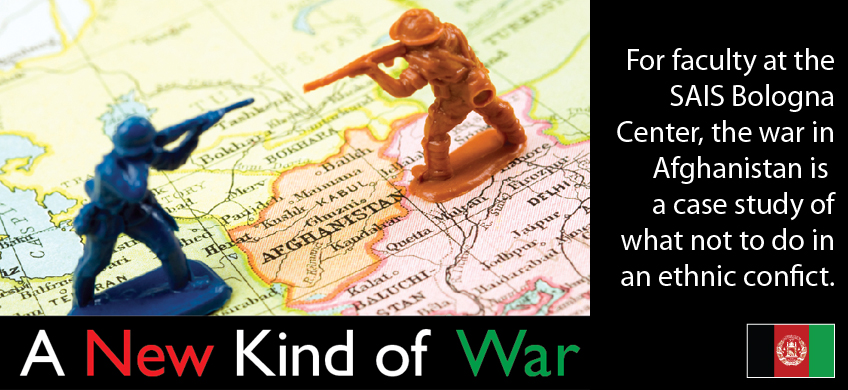
“The Western intervention in Afghanistan was so misconceived from the beginning,” Kühne continues. “A further profound misconception of the West was that it would be possible to build up a functioning Afghan army and police force in a few years, although Vietnam already had proven that this is not feasible.”
Yet another mistake, say the SAIS experts, is that those steering U.S. policy in Afghanistan have failed to recognize that organized crime and ethnic conflict make excellent bedfellows. Strazzari has studied the hidden economies that underlie small but ferocious wars. He has mapped how criminal networks benefit from political turmoil.
Strazzari was a student in the 1990s at the University of Bologna, the oldest university in Europe, just a few steps from the Bologna Center. When Yugoslavia fell apart in paroxysms of violence and ethnic cleansing, he turned his attention there. He and some friends made regular trips through the war-torn nation, making contact with
student organizations, discussing politics, and bringing in basic supplies like fax machines and paper. Moving in and out of Sarajevo, Strazzari observed the routine paying of bribes at Serb, Croatian, and Bosnian checkpoints, and how humanitarian aid fueled a large black market “that had to do with the bare survival of the many
and the enrichment of the few.” Stalemate proved to be a profitable situation for some factions in the conflict. He says, “A host of armed entrepreneurs made deals at night and thrived on shadow economies.”
During the Balkan turmoil, says Strazzari, the amount of heroin that passed through the ex-Yugoslav republics to Western Europe had a major destabilizing impact and lasting consequences for the emerging political systems. He sees analogies to Afghanistan. “You can’t understand Afghanistan if you don’t understand the warlords,” he says, noting that many of them have profited from the lucrative heroin trade that has burgeoned in their territories during years of warfare. “It is difficult to fight illicit economies when they are linked to the same militiamen who have been made, one way or another, a building block of the stabilization effort,” Strazzari adds.
Vendrell’s boots-on-the-ground perspective matches Strazzari’s. As an example, he points to one of the more prominent militia leaders at the moment, the warlord Matiullah Khan, an illiterate Pashtun who opposed the Taliban with armed followers south of Kabul. Though a suspected kingpin in the opium trade, he got a lucrative deal: As reported by Dexter Filkins in June in The New York Times, the NATO military pays him a reported $2.5 million a month to keep open for NATO convoys the highway between Kandahar and Tirin Kot, site of a U.S. Special Forces base. The highway had been subject to frequent Taliban attack. Now Matiullah can charge NATO $1,200 per truck for safe passage. If peace were to come to his province, Matiullah would lose that income, which he claims now helps to support 15,000 people.
Several costly mistakes, say the SAIS experts. The ultimate resolution? They believe probably some kind of agreement forged among Karzai, the warlords, and the Taliban. “People say you have to be inclusive to find a way to peace,” Kühne says. “That may be so, but if you just bring in the crooks, the criminals, and the terrorists, what have you been fighting for anyway?”
Jay Pridmore is a freelance writer based in Chicago.
